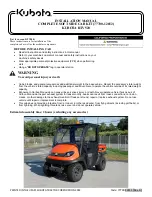
Sevcon Troubleshooting
Page 10
Electrical Troubleshooting
Test 4. KEY FAULT
TEST 4.3:
Test the voltage at the cold side (violet/black wire)
of the key switch.
If the voltage equals battery volts, then skip
ahead to test #4.4.
If the voltage does not equal battery volts,
then replace the key switch.
Stop trouble shooting here and repair the
problem. When the repair is completed,
completely retest the vehicle before lowering
the drive wheels to the ground.
TEST 4.4:
Check the wire from the cold side of the key switch
to pin #1 on the 12 pin logic card connector for
open circuits.
NOTE: Your vehicle may be equipped with a charger
interlock relay. The charger interlock relay
disables the control system when the
charger is connected to its power source.
The interlock relay contacts are in series with
the wire from the cold side of the key switch
to pin #1 on the 12 pin logic card connector.
The relay is located in the charger cabinet.
Stop trouble shooting here and repair the
problem. When the repair is completed,
completely retest the vehicle before lowering
the drive wheels to the ground.
Typical Circuit Breaker
After any repairs are made, completely retest
the vehicle before lowering the drive wheels to
the ground. Failure to retest the vehicle could
result in unexpected movement of the vehicle
resulting in injury or property damage.
Stop, do not continue. Reaching this point
indicates a failure in the Sevcon power unit
or an error was made during testing. Confirm
all previous tests were performed correctly
before replacing the Sevcon power unit.
STOP
TEST 4.1:
Turn the key switch ON and place the forward and
reverse switch in the center OFF position
Perform the following tests:
Test the voltage at pin #1 on the 12 pin logic card
connector.
If the voltage equals battery volts, then skip
ahead to Test #5.
Test the voltage on both terminals of the battery
voltage positive circuit breaker (see below).
If the voltage on both terminals equals
battery volts, then skip ahead to test #4.2.
If the voltage on both terminals does not
equal battery volts, then check the circuit
breaker and wiring to the main circuit breaker
and to the batteries for open circuits.
Stop trouble shooting here and repair the
problem. When the repair is completed,
completely retest the vehicle before lowering
the drive wheels to the ground.
TEST 4.2:
Test the voltage at the hot terminal (red wire) on
the key switch.
If the voltage equals battery volts, then skip
ahead to test #4.3.
If the voltage does not equal battery volts,
then check the wiring from the key switch to
the battery voltage positive circuit breaker.
Stop trouble shooting here and repair the
problem. When the repair is completed,
completely retest the vehicle before lowering
the drive wheels to the ground.
Summary of Contents for TT-316-36
Page 2: ......
Page 6: ...TAYLOR DUNN...
Page 12: ...TAYLOR DUNN...
Page 28: ...TAYLOR DUNN...
Page 76: ...TAYLOR DUNN...
Page 82: ...TAYLOR DUNN...
Page 96: ...TAYLOR DUNN...
Page 99: ...Sevcon Troubleshooting Page 3 Electrical Troubleshooting Identifying Your Controller...
Page 120: ...TAYLOR DUNN...
Page 134: ...TAYLOR DUNN...
Page 138: ...Illustrated Parts Page 2 Front Fork...
Page 140: ...Illustrated Parts Page 4 Front Brakes...
Page 142: ...Illustrated Parts Page 6 Tilt Steering Column and Gear...
Page 146: ...Illustrated Parts Page 10 Transmission Differential Case Rear Axle...
Page 148: ...Illustrated Parts Page 12 Rear Brakes Master Cylinder 8 Brake Body...
Page 150: ...Illustrated Parts Page 14 Rear Suspension...
Page 152: ...Illustrated Parts Page 16 Motor...
Page 156: ...Illustrated Parts Page 20 Brake Lines...
Page 158: ...Illustrated Parts Page 22 Wheels and Tires Ref wheel hub 1 2 5 assembly 4 3 6 7 8 9 10...
Page 164: ...Illustrated Parts Page 28 Miscellaneous Frame and Body...
Page 168: ...Illustrated Parts Page 32 Decals...
Page 172: ...TAYLOR DUNN...
















































